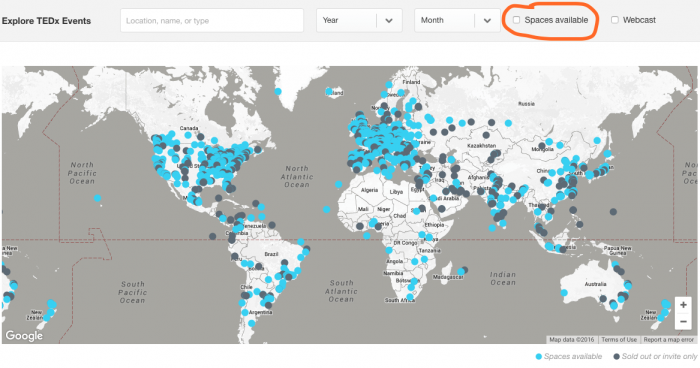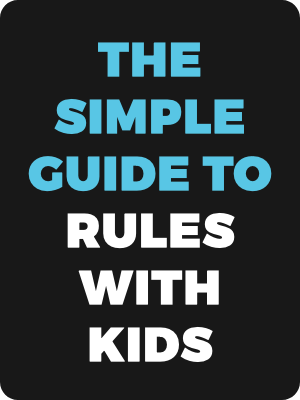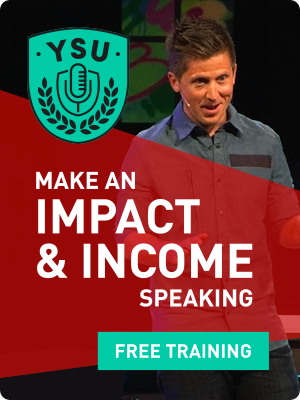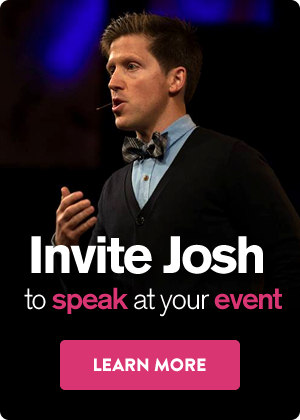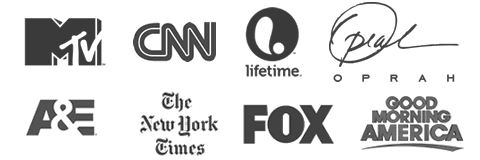What I Learned Writing, Delivering & Promoting a TED Talk Seen by 4M People
The TED talk format offers a compelling challenge to communicators:
Clearly communicate a game-changing idea in just 18 minutes.
So after years of watching/fanboying from the sidelines, I decided it was time to jump in with an idea I’m deeply passionate about.
If you’ve followed my work for any amount of time, you can probably recite this idea with me:
“Every kid is one caring adult away
from being a success story.”
That message is central to all I do. And in this next phase of my career, my goal is to get that message into the hearts and minds of as many adults as possible.
As of this writing, the video from my TED talk has been seen by more than 4 million people and counting. It’s been featured by Upworthy and Kid President. It’s also brought in 113+ speaking requests (proof). MOST importantly, though, it’s generated some great conversation on a topic I care about: investing quality time in young people.
Don’t get me wrong – it’s definitely not a perfect talk. But I learned a few things along the way I’m hoping will help make your good talk GREAT, and your great talk EVEN BETTER.
So let’s get to it: Everything I learned while writing, delivering and promoting this TEDx talk:
THE PREP
Delivering a strong TED talk is all about what you do BEFORE you take the stage, not WHEN you take the stage.
I had decided from the beginning I shouldn’t craft my TED talk alone. I knew my strengths and weaknesses and wanted help from people who could fill in the gaps.
So the first thing I did after picking a speaking date was pick a team.
My team consisted of four players, including me. Here are the positions each of us played:
1. The Editor-In-Chief – To provide the big picture, to set the course and make sure the team stays on course. This person oversees the process of pulling out every word, phrase or idea that doesn’t help make the main point the main point.
2. The Writing Workhorse – To generate the bulk of the words. Under the direction of the editor-in-chief, they craft the intro, body, and conclusion of the talk. To take ramblings, ideas, conversations, and turn them into an actual rough draft of a talk.
3. The Scientist – To fact-check the content and make sure the message is devoid of distractions and misinformation.
4. The Creative – To infuse the talk with elements that will make it as human and compelling as possible. They also filter for cheesiness, clichés, and timidness.
My position on the team was Editor-In-Chief because “big picture” and editing are my specialties.
For example, the very article you’re currently reading are my ideas and philosophies, but someone else “got it all down on paper.” Then I stepped in to edit and shape the content, ensuring it hit the bullseye.
For you, the opposite may be true: You can write like Michelangelo can sculpt (the artist, not the Ninja Turtle). Awesome! You’ll just need to bring in an editor to ensure your beautiful writing aligns with the bigger vision.
The Scientist and The Creative might be two different people, as they were for me. But they could also be the same person. Or a group of people. The point is they just need to help filter your content to make sure it’s, 1. accurate, and 2. compelling.
Which means they don’t have to be “experts” in their field. The truth is, each of the players on my team weren’t full-time speechwriters or “TED talk-consultants.” They were just friends I knew could improve my idea with their ideas.
The point is this: If you believe your idea is truly worth spreading, then it’s also worth crafting with a team.
THE MORE RUNWAY, THE SMOOTHER THE LANDING
I selected a TEDx event ONE FULL YEAR out from the day I started preparing. Why?
Because landing a great TED talk is like landing a really big plane: You need a long runway.
In other words, you need a lot of time to write and edit and rewrite and rehearse and rewrite and rehearse and get sick of it and let some time go by and fall back in love with it and edit some more and…you get the point.
(Want to know how to land a TEDx spot? More below!)
Like I often tell the speakers I work with, a great talk isn’t crafted, it’s earned. Because turning your unique stories and ideas into a message that both inspires and helps people is more like going on a pilgrimage than assembling a puzzle.
By that I mean it takes wholehearted effort and a whole lot of time. By giving myself a full year to prepare for my TED talk, I made room for both.
And I’m so glad I did. Because the journey was even tougher than I anticipated. Especially when it came to the writing.
I did about 40 drafts of my 15-minute talk before I ever called in my team. Doing all that work ahead of time provided the best chance to communicate my bigger vision to the them. It also gave the team something solid they could then improve – they weren’t starting from scratch.
We then word-smithed through a couple dozen more drafts, getting the talk shorter and clearer.
For example, we cut the first three paragraphs (below) so the talk could start with a bang, not a “warm-up comedy bit” like I’d originally written:

I made significant cuts even after 40+ drafts.
That required a mental shift for me. Because in the 45-minute keynote talk I’ve presented to millions of students over the years, I usually take the first 10 minutes to warm the crowd up and win them over. Then I move them toward what I want them to learn and take action on.
But I couldn’t do that with TED. Because there’s so little time, I discovered every single word has to count.
You must win the audience AND move the message forward at the same time. Two birds, one word.
(By the way, this is why you should have a killer opening line that grabs a potential viewer’s attention in seconds. But more on that in a minute…)
The point is it took A LOT of rewriting to ensure we made the biggest impact using the fewest words.
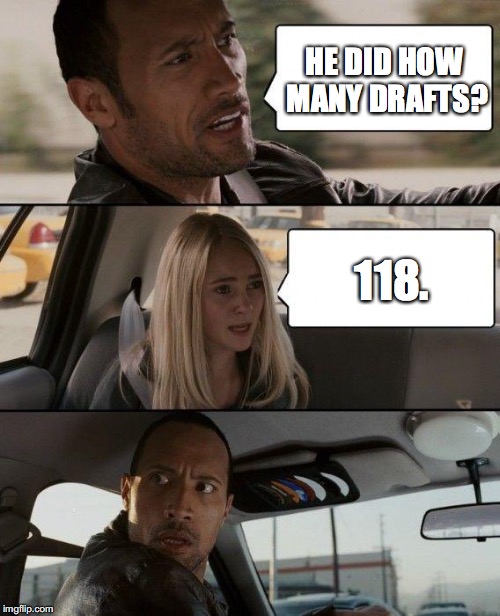
It’s true, Dwayne. We did 118!
Of course, even 118 written drafts didn’t mean it was really done. It just meant I could turn my attention from getting the words on paper to getting the words into my brain.
I did that by committing to run through my talk at least once a day for the four months running up to the main event. I accomplished that using a 3-step process.
The first step was memorization.
I began by simply reading through my talk over and over, exactly as written. I didn’t spend any time thinking about my delivery because I didn’t want to end up sounding like a rehearsal. Instead, I wanted to internalize the words so I could interpret them in real time on stage.
The second step was practicing the talk everywhere I went – on a run, driving to a meeting, while waiting my turn at the check-out line.
(“Excuse me, ma’am – you seem like a caring adult. Before you write that check for your groceries…”)
The third step was to deliver my talk with a few “practice audiences” I could then ask for feedback. This is often what stand-up comics will do, before they film a new special. They will tour smaller clubs and fine-tune their material.
The third step was even more helpful than I expected.
I started with a webcam recording and invited 10 random folks on Twitter to give me their feedback via this Google Survey.
Specifically, I wanted them to tell me…
1.One thing they liked. (to see what stood out)
2.One thing they found unclear. (to see what’s, umm…unclear)
3.What did I just ask them to do? (to confirm they understood)
Based on their responses, I tweaked an additional 5-6 parts of my talk including the last sentence, which became a clear “call to action”.
From there, I booked a series of free gigs with 20-30 people in each so I could test things with a LIVE audience.
I gave the talk at a PTA meeting, at a church event, at a Rotary Club. I asked them to fill out the survey, too.
Based on the collective feedback from the Twitter poll and live presentations, I tweaked the talk again.
Why? Because I had some twisted desire to inflict further editorial pain on myself??? No.
I tweaked the talk again because even after 118 word-by-word revisions and all the fine-tuning that came from countless rehearsals, I’d say the group feedback bumped up the quality of my talk another 20%.
If you’re considering taking on a TED talk, I urge you NOT to skip this part of the process. Because it’s imperative you know how your talk impacts smaller audiences before you take the stage. You’ve worked too hard – and your message is too valuable – not to invest the time.
So…
Was all that prep tedious at times? Of course.
But it was the possibility of changed lives that kept me going, even when I wanted to quit. And that possibility finally led me all the way to a TEDx stage.
THE DELIVERY
OUT OF THE CAGE AND UP TO THE PLATE
The day of my TEDx talk went like this:
I did my normal morning routine. Went for a normal run. Checked off some normal work to-dos. I showered and applied the normal amount of super-secret Japanese hair product.
Then I drove to the venue, gave my talk, thanked the hosts, got in my car, and drove back home.
Why did the day feel so normal?
Because when you spend hundreds of hours in the batting cage, stepping up to the plate is no big deal.
(That’s a sports metaphor, y’all.)
Remember, delivering a great TED talk is all about what you do BEFORE you take the stage, not WHEN you take the stage.
And because I had done all that prep, I was ready.
That said, there were three things I did to ensure my day-of presentation didn’t undermine all the work I’d done preparing. And here they are, in no particular order.
1. Dress To Blend In – This might ruffle the feathers of some self-expressers, but it’s your idea on display, not your outfit. The TED stage isn’t your chance to make a bold fashion statement – save your meat suit for the red carpet, Lady Gaga.
Because while your wardrobe will never MAKE your message, it can distract from it. So keep it simple. Don’t sabotage your impact with that cool magenta top hat you’ve been longing to wear.
Am I a fashion expert? Obviously not.
I’m just saying that by keeping the main thing the main thing – i.e., changing lives with your idea – you’ll remove some of the fear about how you look and end up feeling more comfortable in your delivery.
2. Memorize your talk word-for-word 60-days out. I know. You’re worried it will make you sound robotic. Trust me – it won’t.
Think about it: if you have your talk memorized word-for-word, you’ll actually be more free to be in the moment. But if you’re guessing for words in real-time while the spotlight glares, you’ll almost certainly come off as robotic.
And you’ll develop sweaty armpit spots that will live forever on YouTube.
Memorization is miserable and time consuming, yes. But it will be the thing that helps you own the stage on game day.
3. Research the TEDx venue ahead of time. Even though I’d spent a year working hard to prepare a really great TED talk, I missed one key piece: the venue I’d chosen was hosting their first TEDx conference.
That meant the hosts (who were delightful people) were learning what to do while they were doing it. As a result, the recordings (video and audio), the staging, and the event facilitation were shaky.
In the end, I couldn’t use their video recording to spread the message because of the subpar production. Instead, I used one from a practice talk (see any TEDx logos on the left? Didn’t think so).

Side-by-side comparison. Background doesn’t make a talk, but it can enhance a talk.
That’s why I suggest looking for a TEDx event that has already been hosted at least twice. And get a clear idea of what the venue will look like on the big day by checking out photos from the previous year’s event.
It shouldn’t be too hard to pick a TEDx with a proven track record. In fact, you can click on the map below to see the hundreds of TEDx opportunities every year. (Just check the “spaces available” box and start searching for your ideal spot.)
THE PROMOTION
Dozens of TED talks are uploaded everyday. It’s a very crowded space.
That means the dream you had of posting your talk online and – fingers crossed! – watching it go viral…should be shelved next to “take wheatgrass shots with Kenny G.” (Just me???)
As we’ve seen, NOTHING sets up your video for success better than:
1.Creating a really good talk.
2.Having a strong point of view and a clear message.
3.Expressing something people want to say but can’t quite put words to.
But that doesn’t mean you shouldn’t have a strategy when your video’s ready to post.
I thought of my strategy like throwing a small rock into a big lake. I knew the “waves” created by the rock’s splash would reach much further than I could throw – even though I have a pretty good arm (for a 97-year-old grandmother).
With that in mind, here are the actual emails and timeline I used to make some serious waves for the video.
WAVE #1
When: First day of launch.
Action: Hit up your email list.
Your mailing list is almost always the best place to start any promotional effort, even if it’s just friends and family. Why?
Because they are the ones who have already shown they’re IN. They already believe in you and/or your message. You’ll honor their faithfulness when you give them the news first.
Here’s the email I sent out to my first-wave folks:
Statistically, I am supposed to be dead, in jail, or homeless.
By age 14, I’d been kicked out of so many foster homes that it became a game to me. I acted out because I didn’t trust anyone, and didn’t expect that to change.
So, how come I didn’t end up yet another statistic?
The Answer: ONE Caring Adult WATCH: Every Kid is ONE Caring Adult Away From Being a Success Story
In this 16-minute talk you’ll learn the anecdotal and quantitative difference just ONE caring adult can have in the life of a child.
Best,
Josh
PS We can all think of at least ONE kid that could use our help.
Here’s what Bonnie said; “When I saw this talk, a specific kid immediately came to mind: my 15 year old brother. In two months of applying the specific suggestions Josh gave, our relationship has become better than I could have hoped for.”
Even through the struggle and frustration, we know how amazing and successful our kids could truly be. With time and care, we can help them realize it, too.
WATCH: Every Kid is ONE Caring Adult Away From Being a Success Story
When reviewing the initial results, I was less interested in numbers and more in what viewers were saying about the talk. What were they writing in the comments below the video? When they shared it with their friends, how did they describe it?
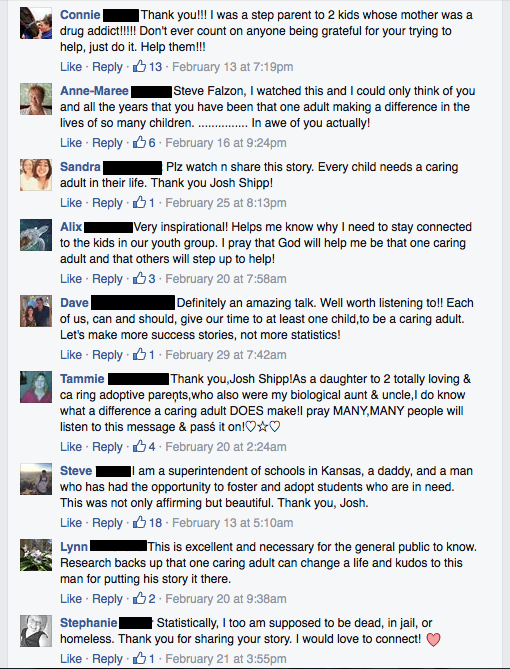
Pay attention to the viewer comments; they’re more informative than the number of views.
That informal research helped me gauge if people were really “getting the message” or were just faithful fans (or both!). It also helped me gather real viewer quotes I could use in future promotions.
Time to activate the second wave.
WAVE #2
When: Three days after launch.
Action: Follow up with viewers.
I used my email management system to help me see WHO clicked to watch the video. Anyone who did click to watch received an email three days later asking them to share the video with their friends, family, and anyone they thought could benefit from the message.

Note the inline “share” buttons (generate yours here). You want your readers to take action IN THAT MOMENT. If they leave the email to “come back later”, they probably won’t come back later.
My excitement grew – people were connecting with the message and sharing it with their friends. It was time for the third wave.
WAVE #3
When: One week after launch.
Action: Reach out to influencers.
My next step was to email and/or call specific influencers of my target audience.
These were people who had established platforms in an arena that served either parents, educators, or caring adults – or all three.
If you’re like me, you probably don’t love asking for favors. But when you think the message is solid and will genuinely helps others, folks will be glad you asked. So do it!
As I made those calls and sent those emails, the video picked up even more steam. Then a couple serendipitous things happened:
The Kid President team and UpWorthy found the video and decided to share it with their followers.
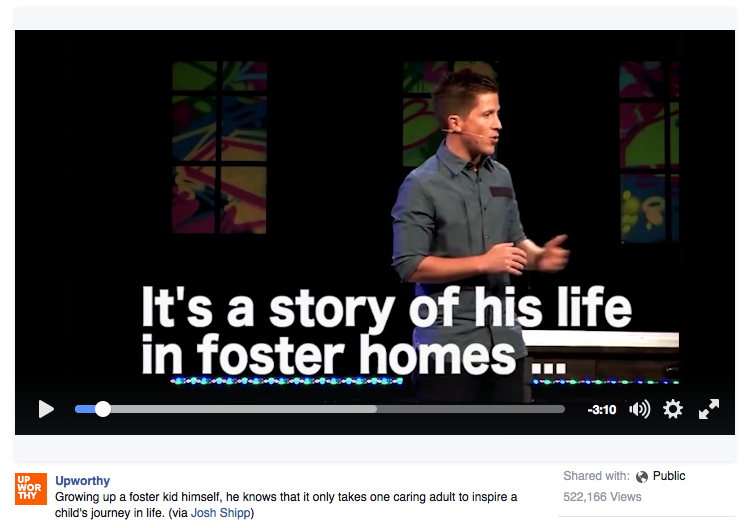
Key influencers will boost views exponentially.
Obviously a ripple-effect strategy doesn’t guarantee you’ll have big names jump in to support you. But it does make it a real possibility.
Thanks to a solid plan, the views reached 4,000,000 and counting (including YouTube, Facebook, etc).
Three final ideas about how to help your message make the biggest splash:
1.Upload natively. Videos will always perform better uploaded on their “home turf” platform. Facebook = Facebook Video. Youtube = YouTube. Instagram = Instagram Video then link to full video. You get the idea.
2.Put captions in your video. When Facebook automatically plays a video, the sound is off. So hook them from the moment it starts playing with captions they can read. Services like rev.com can create the .srt file for you.
3.Have a killer opening line in your talk. For the best chance at grabbing someone’s attention, make the first line of your talk AWESOME. My opening line was “I mastered the art of getting kicked out of foster homes.” When people scrolled by and saw those words captioned at the bottom of my video, they were intrigued and more likely to watch the rest.
Here are three examples of killer opening lines to get you thinking about yours:
“I want to discuss with you this afternoon why you’re going to fail to have a great career.” LARRY SMITH
“…You will live seven and a half minutes longer than you would have otherwise, just because you watched this talk.” JANE MCGONIGAL
“Okay, now I don’t want to alarm anybody in this room, but it’s just come to my attention that the person to your right is a liar.” PAMELA MEYER
NOW, HOW ABOUT YOU?
Here’s what I think. I think you’ve got at least one “idea worth spreading” in you. And I think many would benefit from hearing your idea. A TED talk might be just the right vehicle for delivering your message to wider audience.
Not only will the process improve your speaking (because you’ll be forced to cut every distraction from your key idea). It will also grow your confidence in sharing your idea with a wider audience.
And don’t be discouraged if the resulting video doesn’t get millions of views. Like a friend of mine says, “Your idea doesn’t have to go viral for it to be valuable.”
Like I tell speakers I work with, just make it your goal to be genuinely helpful to others, then do your best to get the word out.
I truly hope you can use the tools and tips I discovered to help your “idea worth spreading” impact more people.
